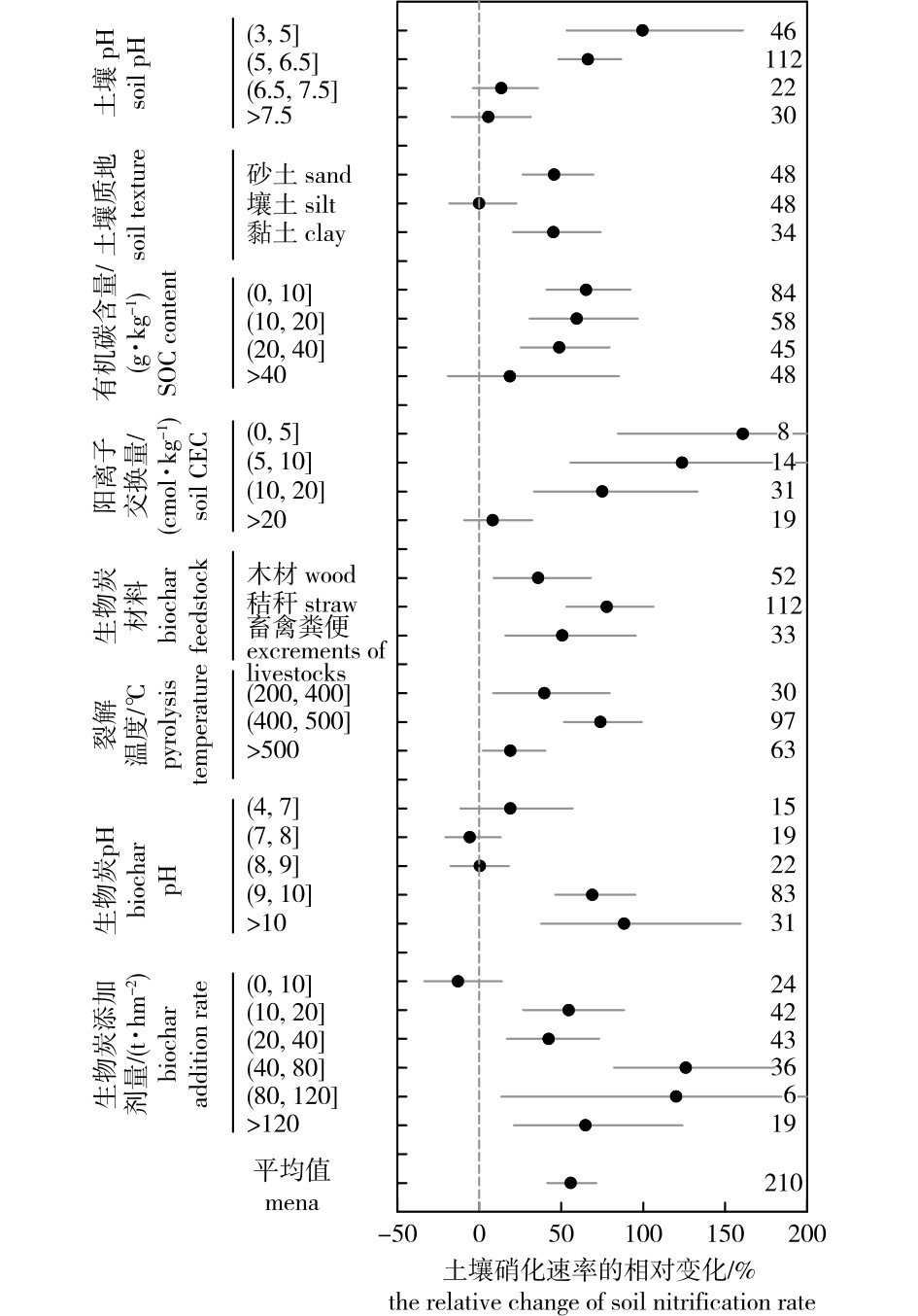 PDF(2003 KB)
PDF(2003 KB)


 PDF(2003 KB)
PDF(2003 KB)
 PDF(2003 KB)
PDF(2003 KB)
生物炭对农田土壤硝化作用的异质性效应研究
Heterogeneous effects of biochar on nitrification in agricultural soils
【目的】硝化作用是农田土壤氮循环的关键过程,与温室气体N2O排放密切相关。生物炭作为新型土壤改良剂,已被证实可显著影响土壤硝化过程,但其对硝化速率以及硝化过程中N2O排放的异质性规律尚不明确,制约了其在农业实践中的科学应用。本研究旨在揭示生物炭对全球农田土壤硝化作用的空间变异规律,为优化生物炭的农业环境效益提供理论依据。【方法】基于94篇已发表文献的研究数据,采用 Meta分析方法系统评估生物炭对土壤硝化作用的影响,并运用机器学习算法解析其全球空间分异特征。【结果】生物炭施用使土壤硝化速率平均提高56%、氨氧化细菌(AOB)丰度增加41%,但对氨氧化古菌(AOA)丰度无显著影响,表明AOB是生物炭调控硝化作用的关键微生物群落。生物炭虽然整体上降低了硝化过程N2O排放系数,但并未降低硝化过程N2O的排放总量。生物炭在低缓冲能力土壤(如酸性、低有机碳或砂性土壤)中表现出对硝化速率、硝化过程N2O排放以及AOB丰度更强的促进作用,主要归因于其碱性效应(提高土壤pH)及结构效应(提升土壤通气性)。空间分析显示,生物炭在热带地区对硝化速率及硝化过程N2O排放的促进作用高于亚热带及温带地区。土壤类型特异性分析表明,生物炭在氧化土、老成土和淋溶土中对硝化速率及硝化过程N2O排放的增加作用较明显,而在始成土、新成土、干旱土和均腐土中对硝化速率的增加作用相对较小,对硝化过程N2O排放没有显著增加的风险。【结论】生物炭在低缓冲性的土壤中可能具有促进硝化作用并增加N2O排放的风险,在实际应用中需根据土壤类型和气候带特征制定差异化施用策略,以实现土壤改良与温室气体减排的双重目标。
【Objective】Nitrification, a key process in the nitrogen cycle, is closely linked to environmental issues such as N2O emissions, a potent greenhouse gas. Biochar, an emerging soil amendment, has been shown to significantly influence nitrification when added to soil. However, the heterogeneous effects of biochar on nitrification rates and N2O emissions remain unclear, limiting its scientific application in agricultural practices.This study aimed to reveal the spatial variation patterns of the nitrification effect of biochar on global agricultural soil, providing a theoretical basis for optimizing the agricultural environmental benefits of biochar.【Method】This study conducted a meta-analysis on data from 94 published studies and applied machine learning techniques to systematically assess the spatial variability of biochar’s effects on nitrification in global agricultural soils.【Result】The meta-analysis revealed that biochar increased soil nitrification rates by an average of 56% and the abundance of ammonia-oxidizing bacteria (AOB) by 37%. However, it had no significant effect on ammonia-oxidizing archaea (AOA) abundance, suggesting that biochar primarily influences AOB abundance in nitrification. Biochar generally reduced the proportion of N2O emissions as a byproduct of nitrification. Its effects on nitrification, nitrification-induced N2O emissions, and AOB abundance were more pronounced in soils with low buffering capacity (e.g., acidic, low organic carbon, or sandy soils), likely due to its liming effect (increasing soil pH) and structural effect (enhancing soil water and air retention) on soils. Machine learning simulations indicated that biochar had a stronger promoting effect on nitrification rates and associated N2O emissions in tropical regions compared to subtropical and temperate zones. It also had a more significant effect on nitrification and associated N2O emissions in Oxisols, Ultisols, Alfisols, and Mollisols. In contrast, biochar had a relatively minor impact on nitrification rates in Inceptisols, Entisols, Aridisols, and Histosols, and posed a lower risk of increasing N2O emissions in these soils.【Conclusion】Biochar may increase soil nitrification rates and associated N2O emissions especially in low-buffering soils. In practical applications, differentiated application strategies for biochar should be developed based on soil types and climate zone characteristics to achieve the dual goals of soil improvement and green house gas emission reduction.

生物炭 / 硝化速率 / N2O / 异质性 / 机器学习 / 空间变异 / 土壤改良
biochar / nitrification rate / N2O / heterogeneity / machine learning / spatial variability / soil improvement
| [1] |
|
| [2] |
王改玲, 陈德立, 李勇. 土壤温度、水分和N-N浓度对土壤硝化反应速度及N2O排放的影响[J]. 中国生态农业学报, 2010, 18(1):1-6.
|
| [3] |
张玉铭, 胡春胜, 董文旭, 等. 农田土壤N2O生成与排放影响因素及N2O总量估算的研究[J]. 中国生态农业学报, 2004, 12(3):119-123.
|
| [4] |
王先芳. 花生壳生物炭对设施菜地土壤硝化作用的影响及其微生物学机制[D]. 哈尔滨: 东北农业大学, 2020.
|
| [5] |
|
| [6] |
王洪媛, 盖霞普, 翟丽梅, 等. 生物炭对土壤氮循环的影响研究进展[J]. 生态学报, 2016, 36(19):5998-6011.
|
| [7] |
|
| [8] |
|
| [9] |
张伟明, 修立群, 吴迪, 等. 生物炭的结构及其理化特性研究回顾与展望[J]. 作物学报, 2021, 47(1):1-18.
|
| [10] |
|
| [11] |
|
| [12] |
|
| [13] |
|
| [14] |
|
| [15] |
|
| [16] |
|
| [17] |
申哲, 张认连, 龙怀玉, 等. 基于机器学习方法的宁夏南部土壤质地空间分布研究[J]. 中国农业科学, 2022, 55(15):2961-2972.
|
| [18] |
|
| [19] |
|
| [20] |
|
| [21] |
|
| [22] |
王翰琨, 吴永波, 刘俊萍, 等. 生物炭对土壤氮循环及其功能微生物的影响研究进展[J]. 生态与农村环境学报, 2022, 38(6):689-701.
|
| [23] |
刘益珍. 生物炭对不同茶龄土壤酸度和氮素转化的影响及微生物响应机理[D]. 杭州: 浙江大学, 2020.
|
| [24] |
吴璜. 施加秸秆生物炭对紫色土反硝化作用及N2O气体排放的影响研究[D]. 重庆: 重庆大学, 2021.
|
| [25] |
|
| [26] |
|
| [27] |
|
| [28] |
|
| [29] |
|
| [30] |
张星, 张晴雯, 刘杏认, 等. 施用生物炭对农田土壤氮素转化关键过程的影响[J]. 中国农业气象, 2015, 36(6):709-716.
|
| [31] |
|
| [32] |
|
| [33] |
庄硕, 陈鸿洋, 张明, 等. 生物质炭施加对新成水稻土碳组分及其分解的影响[J]. 生态与农村环境学报, 2018, 34(11):1010-1018.
|
| [34] |
|
| [35] |
|
| [36] |
|
| [37] |
|
| [38] |
|
| [39] |
刘琦. 生物炭的作物响应、固碳减排及区域适宜性研究[D]. 北京: 中国科学院大学, 2018.
|
/
| 〈 |
|
〉 |